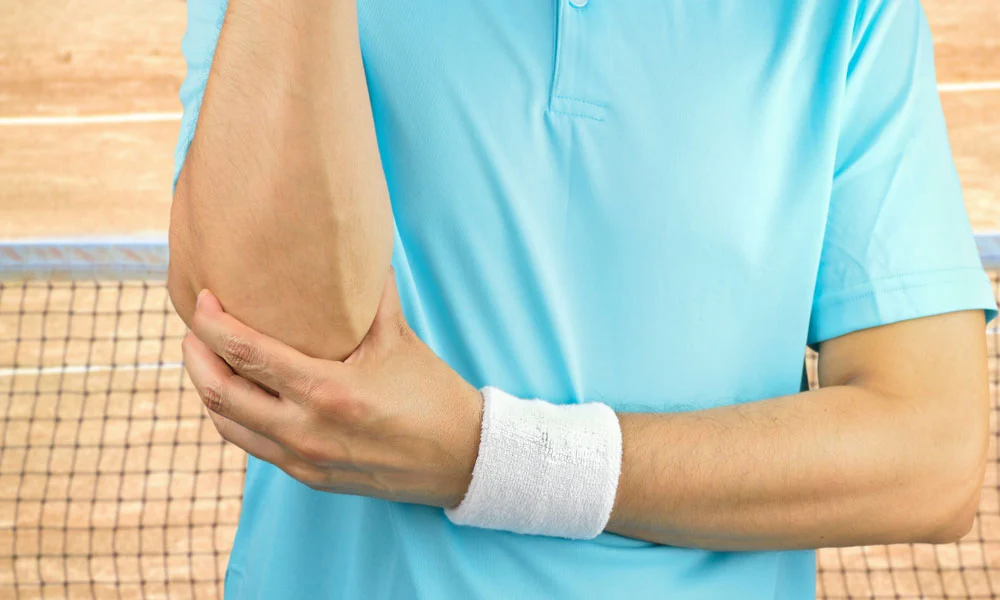Tennis elbow (lateral epicondylitis) is a painful condition that occurs when tendons in your elbow are overstressed, by repetitive movements of the wrist and arm. Unlike the name, athletes are not the only people who develop tennis elbow. Individuals, whose jobs feature the types of motions that can lead to tennis elbow include plumbers, painters, carpenters, and butchers. The pain of the tennis elbow occurs primarily where the tendons of your forearm muscles attach to a bony bump on the outside of your elbow. Pain can also radiate into your forearm and wrist.
Symptoms of Tennis Elbow
Pain on movement
Reduced range of motion
Pain on palpation
Inflammation
Pain at rest, night pain, and daily activities
Causes of Tennis Elbow
Repeated wrist movement activities like household activities, computer use, heavy lifting, sports, etc.
Epicondylitis- Due to single or multiple tears in the common extensors
Inflammation- Inflammation of the bursa
Calcified deposits- Within the common extensor tendon
Activities other than tennis- Tightening a screw, using a wrench, wringing washed clothes, Vigorous handshake
Medical and surgical management
Pain killers and non-steroidal anti-inflammatory drugs are the first modes of treatment in medical management. NSAIDs are useful in reducing the inflammation and pain caused by the tennis elbow. The application of creams and gels in the affected area can give pain relief. Side effects such as nausea, and vomiting can cause by NSAIDs.
If these treatments are less effective, doctors may suggest steroid injections directly injecting to the affected area. Steroid injections give only short-term relief. If they are giving better relief need to take up to 3 injections with 3 to 6 months gap.
If the symptoms are not responding after 6-12 months of non-surgical management doctor may suggest surgery. Surgery is not a primary option for the management of the tennis elbow. Removal of damaged tendons helps to relieve the pain; it can be an open or arthroscopic surgery.

Ayurvedic management
Ayurvedic treatment is a holistic approach by the combination of diet and lifestyle changes.
Medicines from the natural origin are used in the homeopathic management of tennis elbow to reduce pain, inflammation, and stiffness. Tennis elbow can be effectively treated along with exercises under the inspection of a therapist. Need to advise the patient to limit the stressful activities that aggravate the symptoms.
Certain poses in yoga therapy are also found effective in tennis elbow, but the patient should avoid some poses which are stressful for the elbow.
Physiotherapy management
Non- operative management of tennis elbow is by relieving pain and controlling inflammation. By providing rest and avoiding painful activities, we can relieve pain. Elevation of the affected area and icing can reduce inflammation. An elbow brace can also use to limit movements. Patient education is also important for pain management. Modalities like IFT, US, and TENS are used for pain management. Once the pain subsides, we can start with a proper exercise program and manual therapy techniques.
Extracorporeal Shockwave Therapy (ESWT) is an advanced modality for the treatment of musculoskeletal conditions and its very effective in lateral epicondylitis. ESWT uses sound waves (high amplitude pulses of mechanical energy) to break up infected tissues and stimulate the rapid healing process. The energy triggers regeneration and reparative processes of the bones, tendons, and other soft tissues. ESWT is used to treat chronic, sub-acute, and acute conditions. After the shockwave session cryotherapy is advised to avoid muscle soreness.
If you are experiencing elbow pain or have been diagnosed with tennis elbow, please feel free to reach out to us for a consultation and assessment.

